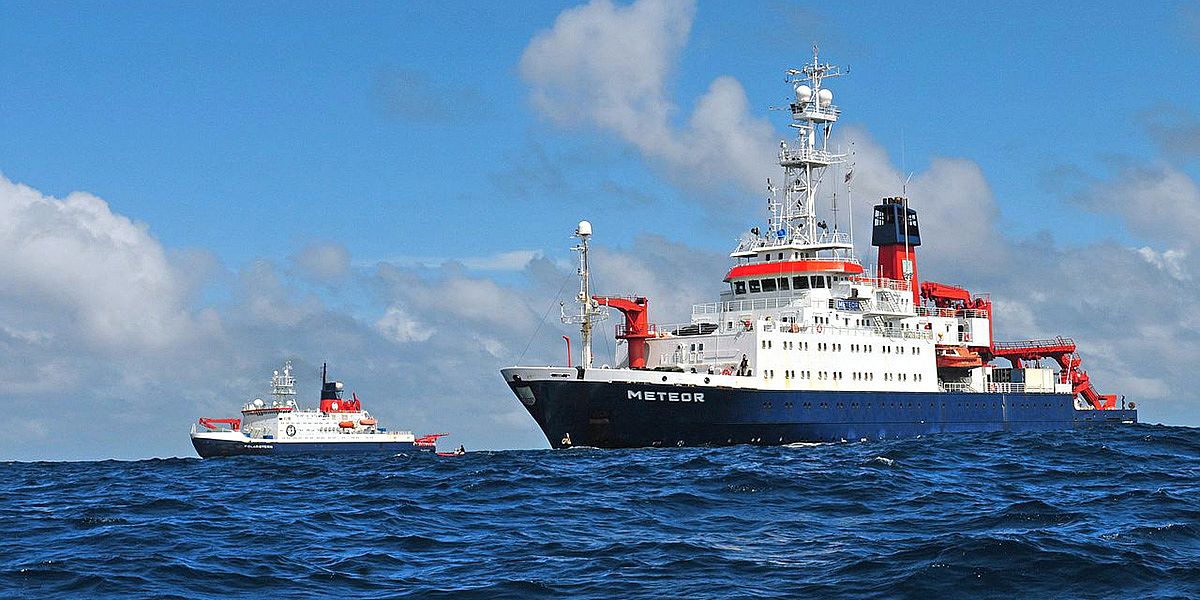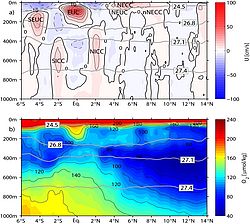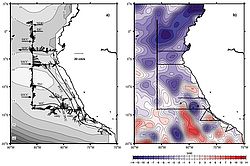In the equatorial Atlantic and Pacific a complicated system of eastward and westward directed zonal currents exist. In the Atlantic latitudinally alternating zonal jets with observed amplitudes of a few centimeters per second contribute to the ventilation of the oxygen minimum zone. Changes in the strength of a zonal jet affect mean oxygen levels in the oxygen minimum zone. A decrease in the core of the oxygen minimum zone of the tropical eastern Atlantic in the last 30 years could be related to a reduction of the system of zonal jets acting on the background gradients (Brandt et al. 2010).
In the eastern equatorial Pacific the differences between eastward and westward flows are typically 10-50 mmolkg-1 (Stramma et al. 2010). As in the equatorial Atlantic the oxygen level at the equator is higher than in the surrounding oxygen-poor regions. Particularly in the upper thermocline, the Equatorial Undercurrent is responsible for the strongest supply of oxygen. Different to the Atlantic, however, the off-equatorial eastward currents don’t supply oxygen to the oxygen minimum zones in the eastern tropical Pacific. During 2 Meteor cruise legs in the eastern tropical South Pacific in early 2009 as well as in late 2012 cyclonic and anticyclonic eddies were observed transporting high oxygen water in the cyclonic eddy and low oxygen water in the anticyclonic eddy (Czeschel et al. 2011; Stramma et al. 2013). Hence also eddies are responsible for oxygen changes in the oxygen minimum zones.
Rough estimates from the values derived in these publications and listed for the Pacific in Brandt et al. (2015) resulted in the following contributions:
| Supply by | Atlantic, µmol/kg/year | Pacific, µmol/kg/year |
| Jet advection | 0.6 (30%) | 1.2 (33%) |
| Eddy mixing | 0.75 (35%) | 1.6 (45%) |
| Vertical mixing | 0.65 (34%) | 0.8 (22%) |
| Total ventilation | 2.0 | 3.6 |
Contact: Peter Brandt, Lothar Stramma
Literature
P. Brandt et al. (2010): Changes in the ventilation of the oxygen minimum zone of the tropical North Atlantic. Journal of Physical Oceanography, 40, 1784-1801.
L. Stramma et al. (2010): Eastern Pacific oxygen minimum zones: Supply paths and multidecadal changes. Journal of Geophysical Research, 115, doi:10.1029/2009JC005976. 655–658.
R. Czeschel et al. (2011): Middepth circulation of the eastern tropical South Pacific and its link to the oxygen minimum zone. Journal of Geophysical Research, 116, doi:10.1029(2010JC006565.
P. Brandt et al. (2015): On the role of circulation and mixing in the ventilation of oxygen minimum zones with a focus on the eastern tropical North Atlantic Biogeosciences (BG), 12 . pp. 489-512. DOI 10.5194/bg-12-489-2015.
L. Stramma et al.(2013): On the role of mesoscale eddies for the biological productivity and biogeochemistry in the eastern tropical Pacific Ocean off Peru. Biogeosciences (BG), 10 (11). pp. 7293-7306. DOI 10.5194/bg-10-7293-2013.





